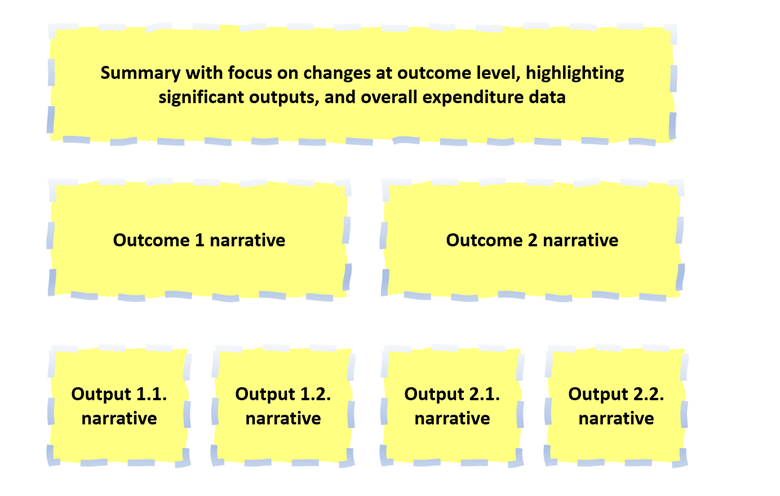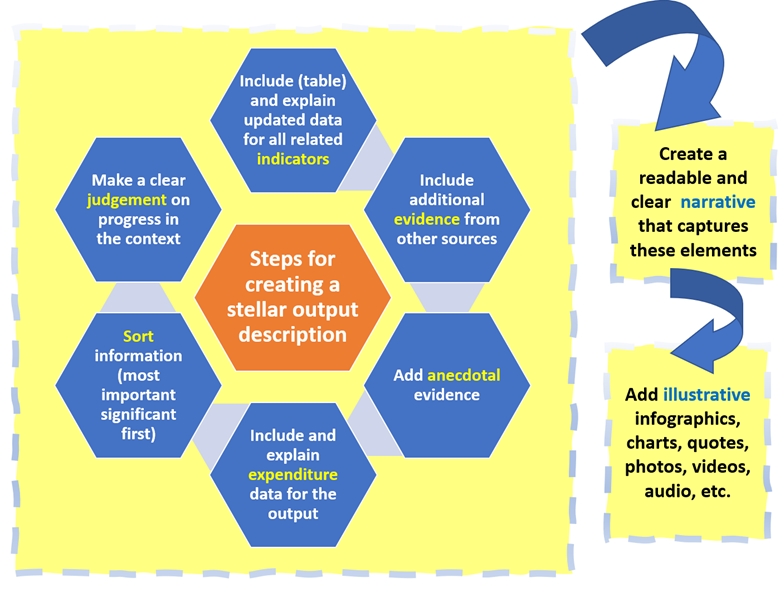Writing reports can often feel like a tedious task. We’ve all been there – staring at a blank page, struggling to find the right words to convey our message. And if we’re bored while writing it, just imagine how other people will feel when they read it. Clearly, we’re doing something wrong.
But reporting is important and can be interesting if done the right way. In this blog post, I’ll show you how you can create effective progress reports that are not boring. By following these tips and tricks, you’ll be able to engage your audience and communicate your message in a clear and concise manner.
First, I will tell you more about how to structure a report. Then I will show you how to go about drafting each output.
How to structure a good report
Start with a summary of what really counts. Then move on to progress towards outcomes. Finally, describe what your organization delivered: outputs.

STEP 1: Sum up what really counts
The structure of progress reports is of utmost importance. Like journalists, one must start with what is most important. Find more about that in this blog post.
Begin with a summary that puts the focus on changes at a level that truly counts – the outcome level. This is where you highlight significant outputs and include overall expenditure data. By doing so, you provide readers with a clear understanding of the key achievements and challenges faced by your organization.
STEP 2: Move on to outcomes.
After presenting this high-level overview, it is time to move on to a more detailed narrative at the outcome level. For each outcome, where multiple outcomes exist, describe the progress that your organisation has achieved towards achieving the outcome. This is where you delve into the specifics and provide readers with a deeper understanding of the work you did.
In this case, it is essential to use outcome indicator data as well as other data from external sources that are available. This could include reports from independent evaluators or feedback from stakeholders. By incorporating this information into your report, you provide readers with a more complete picture of the progress being made.
STEP 3: Finally, describe outputs.
Finally, the third level is where you describe for each output what your organization has delivered. For each output, describe what has been done in the time frame of the report, which often spans a quarter or a year. This is where you provide readers with detailed information on the specific activities and initiatives undertaken by your organization.
Again, it is important to use data from indicators and external data where available. This could include information on how much money has been spent on each output and what impact this has had. By providing this level of detail, you give readers a clear understanding of how your organization is working towards achieving its goals.
By following this structure and including detailed information and examples, you can craft a well-structured and informative progress report that provides readers with a comprehensive understanding of the work being done by your organization.
How to write a stellar output description

STEP 1. Present updated data for all related indicators
Begin by showcasing the most up-to-date data for all indicators related to the output. For instance, if your output is to increase the number of students graduating from high school, you could include data on graduation rates, dropout rates, and test scores. Be sure to explain what the data means and how it relates to the output.
STEP 2. Incorporate additional evidence from other sources
Do not rely solely on indicator data. Include evidence from other sources that support your findings. For instance, you could include reports from independent evaluators or feedback from stakeholders.
STEP 3. Supplement with anecdotal evidence:
Anecdotal evidence can provide valuable insights into the progress being made towards the output. For instance, you could include quotes from teachers or students about the impact of the program. Be sure to include any relevant anecdotes in your report.
STEP 4. Provide expenditure data for the output
It is important to provide information on how much money has been spent on the output. For instance, you could include a breakdown of how much you spent on teacher training, materials, and other expenses. Be sure to include this data in your report and explain what it means.
STEP 5. Organize information (most important and significant first)
Arrange your report in a logical manner, with the most important information presented first. For instance, you could start with a summary of the key findings and then provide more detailed information in subsequent sections.
STEP 6. Make a clear judgement on progress in the context
Finally, make a clear judgement on the progress that your organisation has made towards the output in the context of the overall project or program. For instance, you could say something like “Overall, significant progress has been made towards increasing high school graduation rates, but there is still work to be done in certain areas.”
STEP 7. Craft a readable and clear narrative that captures these elements
Ensure your report is easy to read and understand by crafting a clear narrative that ties all of the information together. Use headings and subheadings to organize your content and make it easy for readers to find what they are looking for. And use change language.
STEP 8. Enhance with illustrative infographics, charts, quotes, photos, videos, audio, etc.
Utilize visual aids like infographics and charts to help convey information in an engaging way. You can also include quotes from stakeholders or photos and videos that help illustrate your points.
By following these steps and including detailed information and examples, you can craft a well-structured and informative progress report on one output.
What to learn more about how to plan, monitor and report on results? Check out our detailed video course on Practical Results Based Management on Udemy.
